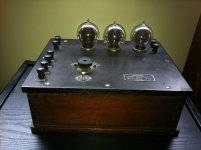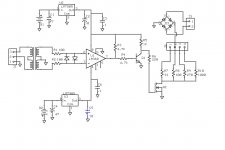Very nice Steve.
Silkscreen or CNC/squeegee?
Thanks, John.
CNC/Lacquer-Stik/cotton cloth.
se
Cool. The retro font is really neat looking.Thanks, John.
CNC/Lacquer-Stik/cotton cloth.
se
jn
Cool. The retro font is really neat looking.
Thanks. Actually that was a bit of an ordeal with this project. I loved that lettering style and have seen it on all kinds of things like schematic and mechanical drawings from the 30s, as well as engraved lettering. It's basically from the old pantograph engravers and hand lettering guides used in drafting.
But as ubiquitous as it was, after quite an exhaustive search, I wasn't able to find a digital font that matched it. Some were kind of close, but none quite matched it.
As it turned out, the folks over in the UK who did our etched brass plates for us still had an old pantograph engraver along with the same lettering style I was looking for. So I had them engrave the entire character set in some of that black/white plastic laminate which I scanned and used as a guide to create digital vector shapes for each character.
I'll see about having someone make a proper digital font from it someday, but for this project, the CNC files were made by placing each letter by hand. It was a bit of work, but I didn't want to compromise. I wanted EXACTLY that lettering style.
se
Oh, and a bit of an ordeal with the binding posts too.
I'd fallen in love with the binding posts used on the old Western Electric 7A amplifier from the 1920s. But after looking at everything Google Images had to offer on binding posts, I wasn't able to find any like them. So initially I opted to go with a miniature five way binding post from Pomona Electric. I didn't like that they were a five way with the hole in the top for miniature bananas, and they didn't have the knurling that I liked on the old ones, but they were closer in size to them.
Then one day I got curious as to how long ago the big Bakelite knob we were using from Davies had been in use. It was a weekend so I couldn't call Davies, so just for fun, I went over to radioshackcatalogs.com where they have digitized all the Radio Shack catalogs going back to the first one in 1939. So I started flipping pages and what do you know, Radio Shack was offering that same knob in their very first catalog. Davis began in 1933 so I knew the knob had to have originated sometime between '33 and '39. Cool.
So I decided to keep flipping through the pages to check out the cool stuff they were selling back in the day. And on the very next page after the knobs I saw... the binding posts! That would have been a bit disappointing as I wasn't able to find them anyway, but the binding post entry, unlike most other entries, had a name. Eby.
Great! With a name, maybe I would be lucky enough to find some old surplus joint that had a big stash of them that I could buy. But as I began searching on Eby, I found that not only were they still in business, but they still had the tooling for those old binding posts. Eby by the way had patented that binding post back in 1925, so I'm certain that the binding posts that graced that old 7A amplifier were made by Eby.
Like the Davies knobs, the binding posts were no longer being produced for any distributors, so we had to have them do a minimum production run, but like the lettering style, I ended up getting exactly what I wanted in the end. I could have lived with the five ways from Pomona, but it would have always nagged at me as a compromise I didn't really want to have to make.
se
I'd fallen in love with the binding posts used on the old Western Electric 7A amplifier from the 1920s. But after looking at everything Google Images had to offer on binding posts, I wasn't able to find any like them. So initially I opted to go with a miniature five way binding post from Pomona Electric. I didn't like that they were a five way with the hole in the top for miniature bananas, and they didn't have the knurling that I liked on the old ones, but they were closer in size to them.
Then one day I got curious as to how long ago the big Bakelite knob we were using from Davies had been in use. It was a weekend so I couldn't call Davies, so just for fun, I went over to radioshackcatalogs.com where they have digitized all the Radio Shack catalogs going back to the first one in 1939. So I started flipping pages and what do you know, Radio Shack was offering that same knob in their very first catalog. Davis began in 1933 so I knew the knob had to have originated sometime between '33 and '39. Cool.
So I decided to keep flipping through the pages to check out the cool stuff they were selling back in the day. And on the very next page after the knobs I saw... the binding posts! That would have been a bit disappointing as I wasn't able to find them anyway, but the binding post entry, unlike most other entries, had a name. Eby.
Great! With a name, maybe I would be lucky enough to find some old surplus joint that had a big stash of them that I could buy. But as I began searching on Eby, I found that not only were they still in business, but they still had the tooling for those old binding posts. Eby by the way had patented that binding post back in 1925, so I'm certain that the binding posts that graced that old 7A amplifier were made by Eby.
Like the Davies knobs, the binding posts were no longer being produced for any distributors, so we had to have them do a minimum production run, but like the lettering style, I ended up getting exactly what I wanted in the end. I could have lived with the five ways from Pomona, but it would have always nagged at me as a compromise I didn't really want to have to make.
se
Attachments
What an ordeal. Sheesh.
To answer our good buddy JC's question "what have ya done for me lately":
I've provided significant works and understandings on ground loop theory and application to single ended and differential I/O electronic systems.
I've detailed ad nauseum how audio equipment as presently designed can be susceptible to ground loop coupling, how to test for that susceptibility, and several methods for combating it. (including how JC's test setup for IC's had a ground loop problem.)
Including some of that "law" type stuff from those dead guys Scott Ampere, Stuart Faraday, and Jeremiah Lenz, part of the Arthur Maxwell gang...
jn
To answer our good buddy JC's question "what have ya done for me lately":
I've provided significant works and understandings on ground loop theory and application to single ended and differential I/O electronic systems.
I've detailed ad nauseum how audio equipment as presently designed can be susceptible to ground loop coupling, how to test for that susceptibility, and several methods for combating it. (including how JC's test setup for IC's had a ground loop problem.)
Including some of that "law" type stuff from those dead guys Scott Ampere, Stuart Faraday, and Jeremiah Lenz, part of the Arthur Maxwell gang...
jn
To answer our good buddy JC's question "what have ya done for me lately":
I've provided significant works and understandings on ground loop theory and application to single ended and differential I/O electronic systems.
I've detailed ad nauseum how audio equipment as presently designed can be susceptible to ground loop coupling, how to test for that susceptibility, and several methods for combating it. (including how JC's test setup for IC's had a ground loop problem.)
Including some of that "law" type stuff from those dead guys Scott Ampere, Stuart Faraday, and Jeremiah Lenz, part of the Arthur Maxwell gang...
Pffft! *rolling eyes and making a certain motion with his right hand* Is that all?
se
In the latest Stereophile it seems I received runner up for amplifier product of the year.
Congrats!
Attached is today's project, anyone care to guess what it is?
Attachments
Is that to balance the poo-poo ...?A superconducting magnetic antimatter confinement bottle insert. Actually, two.
Congrats!
Attached is today's project, anyone care to guess what it is?
Um, a nifty circuit with a built in pin 1 problem??
jn
Attached is today's project, anyone care to guess what it is?
A schematic, from all appearances.
Wayne, what company and product did you work on?
Wayne is a partner at Pass Labs. He must have received it for a preamp.
I thought the "he he.." would have been enough, I couldn't find a sarcastic smilie.
Sometimes it's difficult to tell in this thread...
Wayne, what company and product did you work on?
That would be the XP 30 pre for Pass Labs. I believe you commented on the review John. It was also ion the cover of Absolute Sound where you had a couple of best ever products listed. It isn't saving lives or making global changes but it I will leave that to my wife.
- Status
- Not open for further replies.
- Home
- Member Areas
- The Lounge
- John Curl's Blowtorch preamplifier part II

